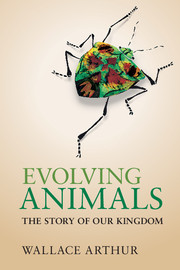Book contents
- Frontmatter
- Dedication
- Contents
- Preface
- Acknowledgements
- 1 What is an animal?
- 2 Before there were animals
- 3 How to make a fossil
- 4 The Cambrian explosion
- 5 How to make a species
- 6 Jellyfish and their kin
- 7 How to make a tree
- 8 The enigmatic urbilaterian
- 9 Animal symmetry and heads
- 10 A plethora of worms
- 11 Trends in animal complexity
- 12 Where the octopus is king
- 13 How to make an animal
- 14 Exoskeletons galore
- 15 Extinction
- 16 Mouth first, mouth second
- 17 Comparing embryos
- 18 Larvae, mouthparts and moulting
- 19 The animal toolkit
- 20 Vertebrate origins and evolution
- 21 From water to land to water
- 22 Variation and inheritance
- 23 Evolutionary novelties
- 24 Human origins and evolution
- 25 Animal plasticity
- 26 The nature of adaptation
- 27 The direction of evolution
- 28 Animal extremophiles
- 29 Extraterrestrial animals?
- 30 The ghost in the machine
- Appendix
- References
- Index
4 - The Cambrian explosion
Published online by Cambridge University Press: 05 August 2014
- Frontmatter
- Dedication
- Contents
- Preface
- Acknowledgements
- 1 What is an animal?
- 2 Before there were animals
- 3 How to make a fossil
- 4 The Cambrian explosion
- 5 How to make a species
- 6 Jellyfish and their kin
- 7 How to make a tree
- 8 The enigmatic urbilaterian
- 9 Animal symmetry and heads
- 10 A plethora of worms
- 11 Trends in animal complexity
- 12 Where the octopus is king
- 13 How to make an animal
- 14 Exoskeletons galore
- 15 Extinction
- 16 Mouth first, mouth second
- 17 Comparing embryos
- 18 Larvae, mouthparts and moulting
- 19 The animal toolkit
- 20 Vertebrate origins and evolution
- 21 From water to land to water
- 22 Variation and inheritance
- 23 Evolutionary novelties
- 24 Human origins and evolution
- 25 Animal plasticity
- 26 The nature of adaptation
- 27 The direction of evolution
- 28 Animal extremophiles
- 29 Extraterrestrial animals?
- 30 The ghost in the machine
- Appendix
- References
- Index
Summary
As we saw in Chapter 2, there have been multicellular life-forms on this planet since about 1200 million years ago (MYA). These first life-forms, however, were not animals; they were probably red algae. Later, in the Ediacaran period, which began some 635 MYA, there are fossils of multicellular creatures, some of which may have been animals; their interpretation remains controversial. The beginning of the Cambrian period, 542 MYA, marks the start of an abundant fossil record of creatures that undoubtedly are animals. In the Cambrian we are faced with a profusion of animal fossils, both those that we recognize as being clearly related to some of today’s animals, and others that are more enigmatic in terms of where to place them in our ‘groups within groups’ system of naming and ordering animals that we inherited from Linnaeus.
Geological periods are often named after places where rocks of the relevant age are found. As we noted in Chapter 2, the Ediacaran period is named after the Ediacara Hills in Australia. The Cambrian is named after Wales. The basis of this latter naming is not as readily apparent as that of the former. But the Welsh name for Wales – Cymru – gets us a bit closer to seeing the connection. And the Roman name – Cambria – makes it crystal clear. There is even a town in Wales where the local newspaper is called The Cambrian News.
- Type
- Chapter
- Information
- Evolving AnimalsThe Story of our Kingdom, pp. 35 - 44Publisher: Cambridge University PressPrint publication year: 2014



